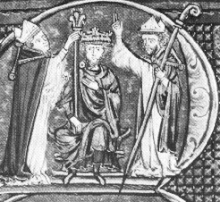Battle
The Egyptians were led by Saad el-Dawleh, former governor of Beirut, while the Crusaders were under the command of King Baldwin I. Baldwin had only 260 cavalry and 900 foot soldiers under his command, leaving him severely outnumbered by the Egyptian army, which was estimated at 32,000 men by Fulcher of Chartres, and downgraded to 3,000–5,000 by modern historians. Upon sighting the Fatimid army, Baldwin arrayed his force in six divisions, commanding the reserve force himself. [5] In the initial attack, the first two Crusader divisions were wiped out while the vanguard took heavy casualties too, with Geldemar Carpinel among the slain. The battle seemed to be lost, but when the third division was pursued after being routed by the Egyptians, Baldwin ordered a counter-attack and committed his reserve. In vicious close-quarter combat, the Crusaders repulsed the Egyptian forces, who retreated in panic as rank after rank buckled under the force of Baldwin's attack. After pursuing the fleeing Fatimids to Ascalon, Baldwin returned to Ramla to plunder the Egyptian camp. This success secured the Kingdom of Jerusalem against the Fatimid Caliphate's advances for the campaigning season. According to Fulcher of Chartres, who was present at the battle, the Fatimids lost around 5,000 men in the battle, including their general Saad al-Daulah. However, Crusader losses were heavy too, losing 80 knights and a large amount of infantry. [5]

The Kingdom of Jerusalem, officially known as the Latin Kingdom of Jerusalem, also known as the Frankish Kingdom of Jerusalem, was a Crusader state that was established in the Levant immediately after the First Crusade. It lasted for almost two hundred years, from the accession of Godfrey of Bouillon in 1099 until the siege of Acre in 1291. Its history is divided into two periods with a brief interruption in its existence, beginning with its collapse after the siege of Jerusalem in 1187 and its restoration after the Third Crusade in 1192.

Year 1102 (MCII) was a common year starting on Wednesday of the Julian calendar.

Baldwin I, also known as Baldwin of Boulogne, was the first count of Edessa from 1098 to 1100, and king of Jerusalem from 1100 to his death in 1118. He was the youngest son of Eustace II, Count of Boulogne, and Ida of Lorraine and married a Norman noblewoman, Godehilde of Tosny. He received the County of Verdun in 1096, but he soon joined the crusader army of his brother Godfrey of Bouillon and became one of the most successful commanders of the First Crusade.

Baldwin III was King of Jerusalem from 1143 to 1163. He was the eldest son of Melisende and Fulk of Jerusalem. He became king while still a child, and was at first overshadowed by his mother Melisende, whom he eventually defeated in a civil war. During his reign Jerusalem became more closely allied with the Byzantine Empire, and the Second Crusade tried and failed to conquer Damascus. Baldwin captured the important Egyptian fortress of Ascalon, but also had to deal with the increasing power of Nur ad-Din in Syria. He died childless and was succeeded by his brother Amalric.

In the Battle of Ager Sanguinis, also known as the Battle of the Field of Blood, the Battle of Sarmada, or the Battle of Balat, Roger of Salerno's Crusader army of the Principality of Antioch was annihilated by the army of Ilghazi of Mardin, the Artuqid ruler of Aleppo on 28 June 1119.
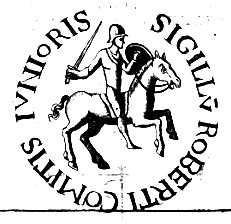
Robert II, Count of Flanders was Count of Flanders from 1093 to 1111. He became known as Robert of Jerusalem or Robert the Crusader after his exploits in the First Crusade.

In the Battle of Azaz forces of the Crusader States commanded by King Baldwin II of Jerusalem defeated Aq-Sunqur al-Bursuqi's army of Seljuk Turks on 11 June 1125 and raised the siege of the town.

The Battle of Montgisard was fought between the Kingdom of Jerusalem and the Ayyubids on 25 November 1177 at Montgisard, in the Levant between Ramla and Yibna. The 16-year-old Baldwin IV of Jerusalem, seriously afflicted by leprosy, led an outnumbered Christian force against Saladin's troops in what became one of the most notable engagements of the Crusades. The Muslim army was quickly routed and pursued for twelve miles. Saladin fled back to Cairo, reaching the city on 8 December, with only a tenth of his army. Muslim historians considered Saladin's defeat to be so severe that it was only redeemed by his victory ten years later at the Battle of Hattin in 1187, although Saladin defeated Baldwin in the Battle of Marj Ayyun in 1179, only to be defeated by Baldwin again at the Battle of Belvoir Castle in 1182.
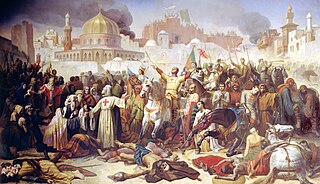
The siege of Jerusalem was waged by European forces of the First Crusade, resulting in the capture of the Holy City of Jerusalem from the Muslim Fatimid Caliphate, and laying the foundation for the Christian Kingdom of Jerusalem, which lasted almost two centuries. The capture of Jerusalem was the final major battle of the first of the Crusades to occupy the Holy Land begun in 1095. A number of eyewitness accounts of the siege were recorded, the most quoted being that from the anonymous Gesta Francorum. Upon the declaration of the secular state, Godfrey of Bouillon, prominent among the leaders of the crusades, was elected ruler, eschewing the title "king." The siege led to the mass slaughter of thousands of Muslims and Jews and to the conversion of Muslim holy sites on the Temple Mount into Christian shrines.

The Battle of Ascalon took place on 12 August 1099 shortly after the capture of Jerusalem, and is often considered the last action of the First Crusade. The crusader army led by Godfrey of Bouillon defeated and drove off a Fatimid army, securing the safety of Jerusalem.

Barisan of Ibelin was an important figure in the crusader Kingdom of Jerusalem, and was the founder of the Ibelin family. His name was later written as "Balian" and he is sometimes known as Balian the Elder, Barisan the Old or Balian I. Barisan was lord of Ramla from 1138 to 1150.
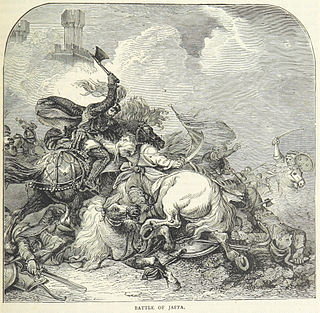
The Battle of Jaffa took place during the Crusades, as one of a series of campaigns between the army of Sultan Saladin and the Crusader forces led by King Richard I of England. It was the final battle of the Third Crusade, after which Saladin and King Richard were able to negotiate a truce. Although the Crusaders did not regain possession of Jerusalem, Christian pilgrims were permitted entry into the city, and the Crusaders were able to retain control of a sizable strip of land stretching from Beirut to Jaffa.
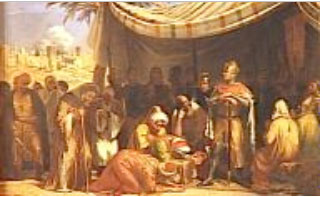
The siege of Ascalon took place in 1153, resulting in the capture of that Egyptian fortress by the Kingdom of Jerusalem.
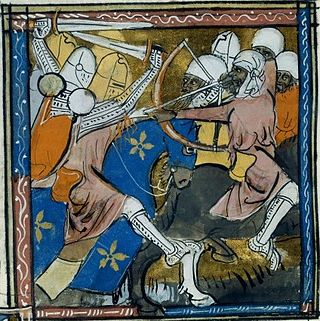
Hugh of Fauquembergues, also known as Hugh of St Omer, Hugh of Falkenberg, or Hugh of Falchenberg was Prince of Galilee from 1101 to his death. He was Lord of Fauquembergues before joining the First Crusade. Baldwin I of Jerusalem granted him Galilee after its first prince, Tancred, who was Baldwin's opponent, had voluntarily renounced it. Hugh assisted Baldwin against the Fatimids and made raids into Seljuk territories. He established the castles of Toron and Chastel Neuf. He died fighting against Toghtekin, Atabeg of Damascus.
The Battle of Hab, also known as the Second Battle of Tell Danith, occurred on August 14, 1119, where a Crusader army commanded by King Baldwin II of Jerusalem won a disputed victory over a Muslim army led by Ilghazi of Mardin since the Muslim army claimed it as a victory also. The battle stabilized the Principality of Antioch, which had suffered a disastrous defeat only weeks before. Baldwin II managed to re-take all of the castles conquered by Ilghazi and prevented him from marching on Antioch.
In the Battle of Yibneh (Yibna) in 1123, a Crusader force led by Eustace Grenier crushed a Fatimid army from Egypt sent by Vizier Al-Ma'mun between Ascalon and Jaffa.
The military history of the Crusader states begins with the formation of the County of Edessa in 1097 and ends with the loss of Ruad in 1302, the last Christian stronghold in the Holy Land.

The SecondBattle of Ramla took place on 17 May 1102 between the Crusader Kingdom of Jerusalem and the Fatimids of Egypt.

The ThirdBattle of Ramla took place on 27 August 1105 between the Crusader Kingdom of Jerusalem and the Fatimids of Egypt. The town of Ramla lay on the road from Jerusalem to Ascalon, the latter of which was the largest Fatimid fortress in Palestine. From Ascalon the Fatimid vizier, Al-Afdal Shahanshah, launched almost annual attacks into the newly founded Crusader kingdom from 1099 to 1107. Of the three battles the Crusaders fought at Ramla early in the twelfth century, the third was the most bloody.

The timeline of the Kingdom of Jerusalem presents important events in the history of the Kingdom of Jerusalem—a Crusader state in modern day Israel and Jordan—in chronological order. The kingdom was established after the First Crusade in 1099. Its first ruler Godfrey of Bouillon did not take the title of king and swore fealty to the Latin Patriarch of Jerusalem, Daimbert. Godfrey's brother and successor Baldwin I was crowned the first king of Jerusalem without doing homage to the patriarch in 1100. By 1153, Baldwin I and his successors captured all towns on the Palestinian coast with the support of Pisan, Genoese and Venetian fleets and also took control of the caravan routes between Egypt and Syria. The kings regularly administered other crusader states—the Counties of Edessa and Tripoli and the Principality of Antioch—on behalf of their absent or underage rulers.
